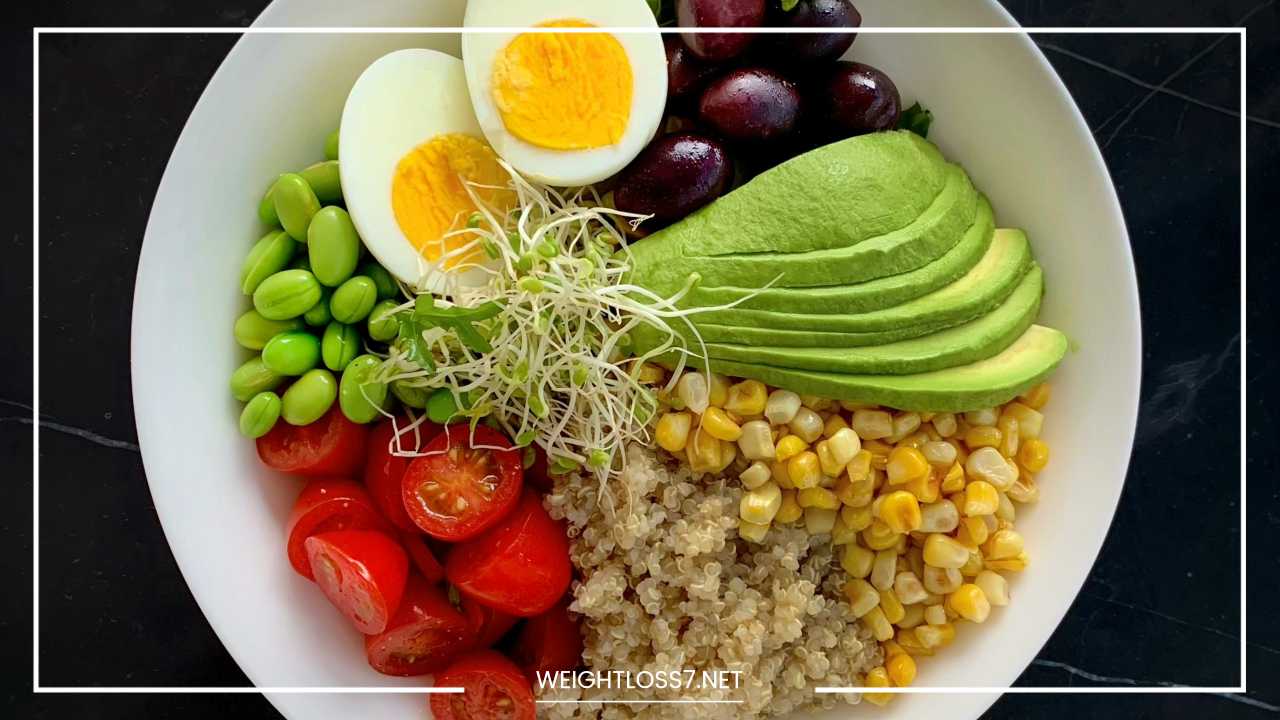High Protein Diet for Weight Loss

High Protein Diet
Shedding Pounds with Protein: A Guide to High-Protein Diets for Weight Loss
In the ever-evolving world of weight loss strategies, high-protein diets have consistently claimed a prominent spot. But what exactly is a high-protein diet, and can it truly help you achieve your weight loss goals?
This comprehensive guide delves into the science behind protein and weight loss, explores the benefits and potential drawbacks of this dietary approach in greater detail, and equips you with the knowledge to craft a sustainable high-protein plan for lasting results.
Why Protein? The Science of Satiety and Metabolism Explained
Protein is a macronutrient that plays a crucial role in various bodily functions, from building and repairing tissues to regulating hormones.
When it comes to weight loss, protein shines due to its impact on satiety and metabolism. Let’s delve deeper into the science behind these effects:
-
Feeling Full for Longer: The Power of Peptide YY and GLP-1: Protein takes longer to digest compared to carbohydrates. This extended digestion process triggers the release of peptides like Peptide YY (PYY) and Glucagon-like Peptide-1 (GLP-1) in the gut. These peptides act as messengers, sending signals to the brain indicating satiety and fullness. As a result, you feel satisfied for longer periods, reducing cravings and preventing overeating, a significant factor in weight management. Studies have shown that high-protein diets can significantly decrease levels of ghrelin, the hunger hormone, further contributing to appetite control.
-
Boosting Metabolism: The Thermic Effect of Protein: Protein has a thermic effect, meaning your body burns more calories digesting and utilizing it compared to fats or carbohydrates. This thermic effect is due to the energy required for various processes involved in protein metabolism, such as breaking it down into amino acids and transporting them throughout the body. While the exact calorie burn from the thermic effect is modest (around 10-30% of the calories from protein), it can contribute to weight loss over time, especially when combined with a calorie deficit.
-
Preserving Muscle Mass: The Importance of Muscle Protein Synthesis: During weight loss, there’s a risk of losing muscle along with fat. Muscle mass is metabolically active, meaning it helps burn more calories at rest. This is where protein comes in. Protein is essential for muscle protein synthesis, the process of building and repairing muscle tissue. By ensuring adequate protein intake, you can help preserve muscle mass, which not only maintains your strength and physical function but also helps you burn more calories at rest, even when you’re not actively exercising.
Weighing the Benefits: A Comprehensive Look at the Advantages of a High-Protein Diet
Here’s a breakdown of the key advantages you can expect with a well-designed high-protein diet:
-
Enhanced Satiety and Appetite Control: As discussed earlier, protein keeps you feeling fuller for longer, reducing cravings and aiding in portion control. This can be immensely helpful in managing calorie intake and promoting a calorie deficit, essential for weight loss. Studies have shown that high-protein diets can lead to reduced calorie intake compared to diets lower in protein.
-
Improved Body Composition: Building Muscle While Losing Fat: High-protein diets can help you lose weight while preserving muscle mass. This leads to a more sculpted physique and a higher metabolism, even at rest. Muscle tissue burns more calories than fat tissue, so preserving muscle mass can significantly impact your weight loss journey and long-term weight management.
-
Increased Strength and Performance: Protein is vital for building and repairing muscle tissue. If you’re physically active, a high-protein diet can support muscle growth and improve your exercise performance. Protein helps with muscle recovery after exercise, allowing you to train harder and potentially see better results in terms of strength, endurance, and overall fitness.
-
Potential Blood Sugar Control Benefits: Studies suggest that protein may help regulate blood sugar levels by promoting insulin sensitivity and reducing the release of glucagon, a hormone that raises blood sugar levels. This can be particularly beneficial for individuals with pre-existing blood sugar concerns or those at risk of developing type 2 diabetes.
-
Bone Health: Protein plays a role in bone health and density. While calcium is often the first nutrient associated with strong bones, protein is also crucial for maintaining bone structure and preventing osteoporosis, especially as we age.
Beyond Weight Loss: Additional Benefits of a High-Protein Diet
A well-designed high-protein diet can offer benefits beyond just weight loss. Here are some additional advantages:
- Improved Mood and Cognitive Function: Studies suggest that protein intake may influence brain function and mood regulation. Protein is a precursor to neurotransmitters, chemicals that play a role in mood, memory, and focus. Ensuring adequate protein intake can potentially support cognitive function and overall well-being.
- Stronger Immune System: Protein is essential for building and maintaining a healthy immune system. Antibodies, which are disease-fighting proteins, are made up of amino acids, the building blocks of protein. Consuming adequate protein ensures your body has the necessary resources to produce enough antibodies to combat viruses, bacteria, and other pathogens.
Weighing the Other Side: Potential Drawbacks of High-Protein Diets and How to Mitigate Them
While high-protein diets offer significant weight loss benefits, it’s essential to acknowledge potential drawbacks and explore strategies to mitigate them:
-
Strain on Kidneys: For individuals with pre-existing kidney problems, a high protein intake can put additional strain on these organs. The kidneys are responsible for filtering waste products from the blood, and a high protein diet increases the workload of filtering nitrogenous waste products from protein metabolism. Consulting a doctor before embarking on a high-protein plan is crucial for such individuals. To minimize the strain, ensure adequate hydration and prioritize high-quality protein sources that are generally easier for the kidneys to process, such as plant-based proteins and lean meats.
-
Risk of Nutrient Deficiencies: If not planned well, a high-protein diet can crowd out other essential nutrients like fiber, vitamins, and minerals found in fruits, vegetables, and whole grains. Focusing solely on protein sources and neglecting other food groups can lead to deficiencies. To counter this, ensure your plate includes a variety of colorful fruits and vegetables, whole grains, and healthy fats alongside your protein sources.
-
Potential for Constipation: A high-protein, low-fiber diet can lead to constipation. Fiber promotes regularity and gut health. Include plenty of fruits, vegetables, and whole grains in your diet for adequate fiber intake. Additionally, staying hydrated is crucial for preventing constipation.
-
Cost Considerations: Protein-rich sources like lean meats, fish, and certain legumes can be expensive compared to processed carbohydrates. Budgeting and exploring cost-effective protein options are key for long-term sustainability. Here are some tips for staying on budget with a high-protein diet:
- Look for protein sources that are on sale.
- Purchase in bulk and freeze portions for later use.
- Choose protein sources like beans, lentils, and tofu, which are generally more affordable than meat.
- Consider vegetarian protein sources more often.
-
Social Challenges: Sticking to a high-protein diet can be challenging in social settings where meals often revolve around processed foods or carbohydrates. Be prepared to make modifications or politely decline certain dishes. You can also suggest restaurants with protein-rich options or offer to bring a protein-focused dish to share.
Building Your Plate: Crafting a Sustainable High-Protein Diet for Long-Term Success
Now that you understand the pros and cons of high-protein diets, let’s explore how to create a balanced and sustainable plan tailored to your needs and preferences:
-
Focus on Quality Protein Sources: Prioritize lean protein sources like skinless chicken breast, fish (salmon, tuna, sardines), beans, lentils, tofu, low-fat dairy products (Greek yogurt, cottage cheese), and eggs. Limit processed meats like sausages and bacon due to their high saturated fat content. While processed meats can be a convenient protein source, they are often high in sodium and unhealthy fats, which can negate the benefits of a high-protein diet.
-
Don’t Neglect Fruits, Vegetables, and Whole Grains: Include plenty of fruits, vegetables, and whole grains in your diet for essential vitamins, minerals, and fiber. Aim for a colorful plate with a variety of fruits and vegetables in every meal. These plant-based foods provide essential micronutrients that protein sources alone cannot provide and help with satiety and gut health.
-
Healthy Fats are Key: Don’t eliminate healthy fats entirely. Include healthy fats from sources like avocados, nuts, seeds, and olive oil to promote satiety, nutrient absorption, and overall health. Healthy fats help slow down digestion, keeping you feeling fuller for longer, and also aid in the absorption of certain vitamins.
-
Stay Hydrated: Drinking adequate water throughout the day is crucial for overall health and can aid digestion, especially on a higher protein diet. Water helps flush out waste products from protein metabolism and keeps your digestive system functioning smoothly.
-
Portion Control is Essential: Even with protein, portion control is key. Use measuring cups and spoons or follow recommended serving sizes to avoid exceeding your daily protein needs. While protein is satiating, it still contains calories, and consuming excessive amounts can hinder weight loss goals.
-
Find Meals You Enjoy: Sustainability is key to any dietary change. Choose protein sources and recipes you find enjoyable to make sticking to the plan easier. Explore different cuisines and experiment with spices and herbs to add flavor variety to your high-protein meals.
-
Plan and Prepare: Planning your meals and snacks in advance can help you stay on track, especially when you’re busy. Prepare healthy snacks and pre-portion some meals to avoid unhealthy choices when hunger strikes.
-
Don’t Deprive Yourself: Allow yourself occasional treats in moderation. Deprivation can lead to cravings and binge eating. Enjoy a small portion of your favorite dessert or indulge in a cheat meal as part of a flexible approach. Listen to your body’s cues and find a balance that works for you.
Building Your High-Protein Meal Plan: Recipes for Success
Equipping yourself with delicious and easy-to-prepare recipes is crucial for the long-term success of your high-protein diet. Here are some recipe ideas for breakfast, lunch, dinner, and snacks to get you started:
High-Protein Breakfast Ideas:
- Power-Packed Smoothie: Blend Greek yogurt, protein powder, spinach, berries, and a splash of almond milk for a refreshing and protein-rich breakfast.
- Scrambled Eggs with Smoked Salmon and Whole-Wheat Toast: Classic scrambled eggs get an upgrade with protein-rich smoked salmon served on whole-wheat toast for added fiber.
- Cottage Cheese Bowl with Berries and Chia Seeds: A combination of creamy cottage cheese, fresh berries, and chia seeds provides protein, fiber, and healthy fats for a satisfying start to your day.
Protein-Punch Lunch Options:
- Tuna Salad with Whole-Wheat Crackers and Side Salad: Make your own tuna salad with canned tuna in water, chopped celery, red onion, light mayonnaise, and spices. Enjoy it with whole-wheat crackers and a side salad for a balanced lunch.
- Lentil Soup with Whole-Grain Bread: Lentil soup is a hearty and protein-rich vegetarian option. Pair it with whole-grain bread for added fiber and a complete meal.
- Chicken Caesar Salad with Grilled Chicken Breast: A classic Caesar salad gets a protein boost with grilled chicken breast. Opt for a light Caesar dressing or make your own healthy version.
High-Protein Dinner Inspiration:
- Salmon with Roasted Vegetables and Quinoa: Baked salmon is a flavorful and protein-rich main course. Roast vegetables like broccoli, asparagus, and sweet potato for a colorful and nutritious side dish. Serve with quinoa for added protein and complex carbohydrates.
- Turkey Chili with Kidney Beans and Corn: This hearty chili is packed with protein from ground turkey and kidney beans. Corn adds a touch of sweetness, while spices like chili powder and cumin deliver bold flavors.
- Stir-Fried Tofu with Vegetables and Brown Rice: Tofu is a versatile vegetarian protein source. Stir-fry it with a variety of vegetables like bell peppers, broccoli, and mushrooms. Serve over brown rice for a complete and satisfying meal.
Protein-Packed Snacks to Keep You Going:
- Greek Yogurt with Berries and Almonds: Greek yogurt provides protein and calcium, while berries add sweetness and fiber. Almonds offer a healthy dose of fat and keep you feeling full for longer.
- Hard-Boiled Eggs: A classic and convenient protein snack. Hard-boiled eggs are easy to prepare and store, making them a perfect on-the-go option.
- Edamame: Edamame (soybeans) are a great source of plant-based protein and fiber. Enjoy them steamed or roasted for a healthy and satisfying snack.
- Trail Mix with Nuts, Seeds, and Dried Fruit: Make your own trail mix with a variety of nuts, seeds, and dried fruit for a protein and fiber-rich snack that curbs cravings.
Remember, these are just a few ideas to get you started. There are countless delicious and nutritious recipes you can explore to create a high-protein meal plan that suits your taste preferences and dietary needs.
Making Adjustments and Tracking Progress: Optimizing Your High-Protein Journey
As with any dietary approach, it’s important to listen to your body and make adjustments as needed. Here are some tips for optimizing your high-protein journey:
- Track Your Macros: Consider tracking your macronutrients (protein, carbohydrates, and fat) for a short period to understand your baseline intake and ensure you’re hitting your protein goals while maintaining a balanced diet. There are many free apps and online tools available to help you track your macros.
- Listen to Your Body: Pay attention to how you feel on a high-protein diet. If you experience any digestive issues, fatigue, or headaches, it might be a sign that you need to adjust your protein intake or consult a healthcare professional.
- Stay Hydrated: As mentioned earlier, adequate hydration is crucial on a high-protein diet. Aim to drink plenty of water throughout the day to support digestion and overall health.
- Don’t Be Afraid to Seek Help: Consulting a registered dietitian or nutritionist can be helpful, especially if you have underlying health conditions or need personalized guidance in creating a sustainable high-protein plan.
By following these tips and incorporating the information in this guide, you can embark on a successful high-protein journey for weight loss and overall well-being. Remember, consistency and a balanced approach are key to achieving your goals and maintaining a healthy lifestyle.

















